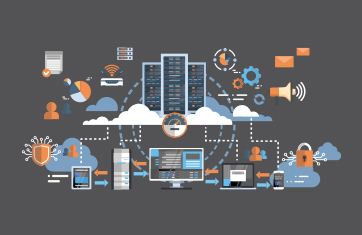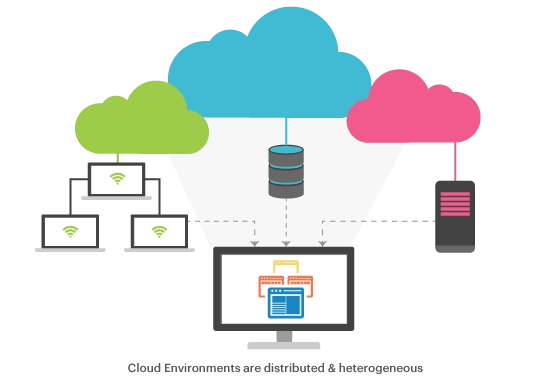What is Cloud Monitoring?
Cloud monitoring is the process of evaluating the health of cloud-based IT infrastructures. Using cloud-monitoring and observability tools, organizations can proactively monitor the availability, performance, and security of their cloud environments to identify and remedy problems before they impact the end user experience or service availability.
Good cloud monitoring and analytics will also allow organizations to right size resources and optimize performance relative to costs. Many organizations monitor cloud service accounts and billing beyond infrastructure to ensure they are protected from unintended cloud bills from anomalous usage.
For enterprises that are accelerating their journey to the cloud—deploying new applications, migrating services to the cloud, and using cloud infrastructures to operate their business—success in cloud computing depends on ensuring that the performance of the applications and their service quality is equal to those deployed in their on-premises data centers. Whether a public, private or hybrid cloud infrastructure is used, holistic performance visibility is required to ensure successful service delivery and achieve high efficiency.
A cohesive Application Performance Monitoring (APM) strategy that focuses on customers’ digital experience, business transactions, application dependencies and infrastructure performance is key to achieving application performance success.
What are the challenges of Cloud Monitoring?
While cloud computing offers enterprises many benefits, it also poses several monitoring and management challenges. Given the distributed and heterogeneous nature of cloud environments, it is difficult to pinpoint the root-cause of performance problems.
- Most cloud infrastructures involve multiple inter-dependent tiers: application, virtualization, storage, network, etc. A problem in one tier affects other tiers—making root cause diagnosis a challenge.
- Cloud environments involve multiple domains of control—one for infrastructure, another for applications, etc. Lack of centralized visibility makes performance monitoring difficult.
- The cloud infrastructure may be shared, having workloads from multiple customers. Surge in demand from one customer’s workload can affect the performance of applications for another customer.
- Monitoring rewritten applications. Depending on the architecture, moving to the cloud may mean that your applications must be rewritten. That monolithic, single-server database application won’t behave the same in the cloud. It will likely be rewritten to take full advantage of the cloud. Because of this, how you monitor it will have to change compared to on-premises.
- While moving to the cloud brings new flexibility, it can also do so at an increased cost. With changes to the application, and how cloud providers bill, you will likely need to monitor tool overhead costs. You’re probably used to monitoring how much data overhead is added because it may affect application performance. But in the cloud, you also need to do this for billing reasons because your organization is now paying for this by the GB.
- Lack of visibility for end-to-end monitoring. When on-premises, you can lack visibility to certain applications or parts of a network because of silos. But in the cloud, there is a new challenge of lacking visibility for every application. Since you don’t control the physical infrastructure, you don’t see everything end-to-end. If there are some performance issues with an application you are monitoring, you won’t fully know if the problem was on your end or on the provider's end. This is a completely new challenge that you have to deal with now in the cloud.
Native cloud monitoring tools such as Azure Monitor or AWS CloudWatch usually require considerable manual set up or scripting / configuration and a level of expertise to set up well. Additionally, these monitoring services are pay-to-use and estimating costs is hard and cost concerns often lead to organizations limiting their monitoring capabilities to avoid charges. Many organizations choose a cloud-neutral third-party monitoring tool to avoid investing in a single cloud and becoming locked-in by the overhead of switching. Native cloud tools are particularly weak at monitoring cloud outages and companies need to adopt certain strategies to ensure their observability and monitoring capabilities are resilient to cloud outages, see: How to Protect your IT Ops from Cloud Outages (eginnovations.com).
How does Cloud Monitoring differ from monitoring on-premises IT systems?
Cloud monitoring and on-premises monitoring differ in several ways due to the distinct nature of the environments. Here are some key differences:
- Infrastructure Location: In on-premises monitoring, the infrastructure being monitored is physically located within the organization's premises. In contrast, cloud monitoring involves monitoring resources and services hosted in a cloud provider's data centers distributed globally.
- Scalability and Elasticity: Cloud environments provide scalability and elasticity, allowing resources to be dynamically scaled up or down based on demand. This dynamic nature requires monitoring tools to adapt and handle the changing infrastructure size and configuration. On-premises monitoring typically deals with a fixed infrastructure, requiring less emphasis on scalability.
- Resource Ownership: In on-premises monitoring, organizations own and have full control over the physical infrastructure, including servers, networks, and storage. Cloud monitoring involves monitoring resources provided by the cloud provider, and organizations have shared responsibility for managing and monitoring these resources.
- Service Abstractions: Cloud environments abstract away the underlying infrastructure, providing higher-level services such as virtual machines, containers, serverless functions, and managed databases. Cloud monitoring focuses on monitoring these services and their performance metrics. On-premises monitoring, on the other hand, typically involves monitoring lower-level infrastructure components directly. Often information that is available to the on-prem admin is deliberately unavailable within a cloud environment for security reasons.
- Visibility and Access: Cloud monitoring often provides enhanced visibility into the performance and health of cloud services through dedicated monitoring portals or APIs provided by the cloud provider. On-premises monitoring may require more manual configuration and setup of monitoring tools to gain visibility into the infrastructure.
- Cost Structure: Cloud monitoring involves monitoring the cost and utilization of cloud resources, which may have a pay-as-you-go pricing model. On-premises monitoring typically involves upfront hardware and software costs, and ongoing maintenance costs are typically incurred for the monitoring infrastructure.
- Security Considerations: Cloud monitoring requires organizations to consider the security aspects of monitoring data and interactions with cloud resources. On-premises monitoring may have a narrower focus on internal security measures.
What are the key metrics and parameters to monitor in a Cloud environment?
Monitoring key metrics and parameters in a cloud environment is essential for understanding the health, performance, and utilization of resources. Here are some key metrics and parameters most Enterprises chose to monitor in a cloud environment:
- Compute Metrics: CPU utilization, memory usage, disk I/O, and network throughput provide insights into the performance and resource consumption of virtual machines, containers, or serverless functions.
- Availability and Uptime: Monitoring metrics such as availability, uptime, and response times can ensure that cloud services and applications are meeting service level agreements (SLAs) and providing reliable performance. It is particularly important that organizations understand how cloud provider SLAs relate to uptime and what they do not cover, for a deeper understanding on cloud SLAs - see: Cloud Application Monitoring for Top Performance (eginnovations.com).
- Network Metrics: Network latency, bandwidth usage, and packet loss can be monitored to identify potential network bottlenecks and ensure smooth data transfer between cloud resources.
- Storage Metrics: Monitoring storage capacity, input/output operations per second (IOPS), and throughput helps manage storage utilization and identify performance issues in cloud storage solutions.
- Cost and Utilization Metrics: Tracking cloud resource utilization, cost breakdowns, and spending trends helps optimize spending and identify cost-saving opportunities.
- Scalability Metrics: Monitoring metrics related to autoscaling, such as instance count, queue length, and scaling events, helps ensure resources are dynamically scaled to handle fluctuating workloads effectively.
- Application Performance Metrics: Monitoring application-specific metrics like response time, request throughput, and error rates provides insights into the performance and health of cloud-hosted applications.
- User Experience Metrics: It is becoming increasingly important for IT teams to monitor user experience usually through a combination of the Real User Monitoring (RUM) and Synthetic Monitoring that capture logon times, latencies, protocol metrics, screen refresh rates and fps (frames per second). Cloud SLAs cover uptime not how performant and responsive the experience is to the customer or employee relying on an application.
- Security and Compliance Metrics: Monitoring security-related metrics like intrusion attempts, unauthorized access attempts, and compliance violations helps maintain the security and compliance of cloud environments.
- Logging and Audit Trails: Monitoring logs and audit trails provides visibility into system events, user actions, errors, and other relevant activities for troubleshooting, security analysis, and compliance auditing.
- Service-Level Agreement (SLA) Metrics: Monitoring SLA metrics specific to cloud services, such as API response time, availability zones, or service quotas, helps track service performance against agreed-upon SLAs.
The specific metrics to monitor may vary depending on the cloud provider, service types used, and the organization's specific requirements and objectives.
What are popular third-party or open-source Cloud Monitoring tools?
Popular third-party monitoring tools often used for cloud monitoring include: Datadog, Dynatrace, eG Innovations, New Relic, Splunk, AppDynamics, Zabbix, Nagios, Prometheus and Grafana.
When choosing a cloud monitoring tool, many organizations need to consider the pros and cons of open-source software (OSs) solutions vs commercially supported options, some considerations are covered here: Top Freeware and Open-source IT Monitoring Tools - IT Glossary | eG Innovations.
Why AIOps is essential for Cloud Monitoring?
AIOps (Artificial Intelligence for IT Operations) has become fundamental to effective cloud monitoring. AIOps features automate auto-discovery and deployment with statistical data analysis, machine learning and algorithms processing and interpreting data at scale beyond human capabilities. Legacy monitoring tools designed for relatively static on-prem use cases typically require manual intervention to configure monitoring and manual setting of metric thresholds and alerting.
AIOps platforms such as eG Enterprise auto-baseline and learn the normal behavior of cloud systems on hour-of-the-day, day-of-the-week, weekly, monthly and long timeframes to provide dynamic thresholds and alerting out of the box. Many AIOps enabled monitoring tools provide automated root-cause analysis that correlates alerts and avoids alarm storms and provides automated root-cause diagnostic information or even automated issue remediation.
The dynamic nature of cloud usage and use of auto-scaling and IaC (Infrastructure as Code) methodologies mean AIOps features are now ubiquitous and essential for cloud monitoring.
Can I monitor multiple clouds such as AWS, GCP and Azure with a single tool? Can I monitor Cloud and on-prem environments with a single tool?
Yes, there are many tools such as eG Enterprise designed to monitor multiple clouds and hybrid and on-prem deployments.
What does an MSP (Managed Service Provider) need from a Cloud Monitoring tool in a multi-tenancy environment?
In a multi-tenancy environment, where a Managed Service Provider (MSP) serves multiple clients, a cloud monitoring tool needs to provide specific features and capabilities to meet the unique requirements of the MSP. Here are some essential aspects an MSP would need from a cloud monitoring tool in a multi-tenancy environment:
- Multi-Tenancy Support: The monitoring tool should support the multi-tenancy model, allowing the MSP to monitor and manage resources and services across different client environments within a single dashboard or interface. It should enable the MSP to create separate views, access controls, and data segregation for each client while maintaining centralized management.
- Client Isolation and Security: The monitoring tool should ensure proper isolation of data and configurations between different clients to maintain data privacy and security. It should provide granular access controls and permissions, allowing the MSP to assign appropriate monitoring privileges to their clients and prevent unauthorized access.
- Flexible Deployment Options: The monitoring tool should offer flexible deployment options, allowing the MSP to choose between on-premises, cloud-based, or hybrid deployments. This flexibility ensures that the monitoring tool can adapt to the specific infrastructure and deployment models of the MSP and its clients.
- Scalability and Performance: The monitoring tool should be capable of handling the scale and performance requirements of monitoring multiple clients simultaneously. It should efficiently collect, process, and analyze monitoring data from numerous client environments without compromising performance or responsiveness.
- Customizable Dashboards and Reporting: The tool should provide customizable dashboards and reporting capabilities, enabling the MSP to create tailored views and reports for each client. This customization allows the MSP to present relevant metrics and insights specific to each client's needs and preferences.
- Alerting and Notifications: The monitoring tool should support configurable alerting and notification mechanisms to promptly notify the MSP and clients about potential issues or anomalies. It should allow customization of alert thresholds, escalation procedures, and integration with popular communication channels like email, SMS, or ticketing systems.
- Performance SLAs and Metrics: The tool should facilitate the monitoring of key performance indicators (KPIs) and service-level agreements (SLAs) for each client. It should provide metrics and reporting capabilities to track and demonstrate compliance with agreed-upon performance metrics.
- Billing and Cost Management: In a multi-tenancy environment, the monitoring tool should offer features for tracking and managing the costs associated with monitoring services across multiple clients. It should provide visibility into resource utilization, cost breakdowns, and cost allocation for billing purposes.
- API and Integration Capabilities: The monitoring tool should have robust APIs and integration capabilities to enable seamless integration with other MSP management systems, ticketing systems, or reporting platforms. This facilitates data exchange and automation of workflows between the monitoring tool and other systems used by the MSP.
By having these features and capabilities, a cloud monitoring tool can effectively support an MSP's operations in a multi-tenancy environment, ensuring efficient monitoring, management, security, and compliance across their client base.


